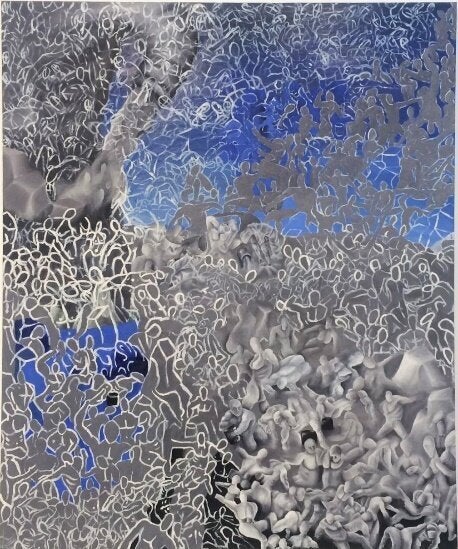Graffiti artist Marck Emaya is a Fine Arts student at Dar al-Kalima University College Arts and Culture in Bethlehem. From childhood he was fascinated with art and in particular graffiti.
Enticed by the colours he saw on walls in the movies he watched with his family, he became addicted and decided he was going to create art of his own. Along with being art student, Emaya spends time teaching children (and even some of their parents) how to draw and paint at the school next door to his university.
In an email exchange before we met one sunny day in his studio, Emaya told me how he uses a surrealist thinking to create his concepts, then mixes abstract and classic art in his paintings. The premise behind his work is to get people to recognise Palestinians as humans and not as terrorists or expendable numbers.
Perception Problem
Emaya explains that the perception problem is two-fold. First is how Palestinians see themselves:
"If you look at people in Palestine, they don't think of themselves as humans and are always looking for ways to prove that they are humans. But who has the authority to tell them whether or not are they are human? We may have different colour skin and speak different languages but put religion aside, put politics aside, put all the bullsh*t aside and you will see in the end we are all human."
Second is how Palestinians are perceived by others. The "Palestinians are terrorists" narrative is having grave impacts on Palestinian lives. Emaya spoke of how others profusely stare at him and his beard as though he is a terrorist. This is especially the case when he travels to other places through Jordon. "The entire journey they watch me. I'm going to keep my beard and break the image they have made of us."
Rethinking Resistance
I asked if he feels the occupation affects his education. He explains he is only able to paint from what he sees: "I cannot paint an angel if I do not see one." The same goes with the sea. Emaya was unable to see the sea until he traveled to study in Greece two years ago - even then it was not in his own land. It was apparent that the restriction of movement and the limitations placed on Emaya play on his mind.

This painting is called "Resistance" and hangs on the studio wall. It conveys the transition that occurs during occupation when human lives become numbers. "When you hear of people dying in the news, you often hear that "1000 have been killed" but there are no real feelings in that number." In this painting Emaya also explains that to simply exist is not enough. To merely be there is a statue stance - so he has painted them as statues. Movement is freedom.
Critical Concepts
Emaya is critical of violent movements saying that Palestinians too are doing bad things along with the occupation. He condemns stone-throwing and believes that the most powerful form of resistance is seeking education and knowledge.
His favorite work is this painting:

A long sketchbook filled with drawings is shown to us too. The concept in these works is to show a human changing to a beast. This proved challenging because changing the figure makes it looks like another creature. So he retained and accentuated core facial features: eyes, nose and mouth to make it more realistic. "Our mouth is always open and our tongue is out, this is to show how we talk but we don't always think."
Emaya explains that if people want to look at Palestine they cannot just look at the Palestine today but must look through the history- what has happened, who has been present and try not to only listen to Palestinians stories but the Israelis stories too before making up your own mind.
The message Emaya wants to leave is this:
"Just look at us as humans, deal with us as humans, and that's all I want. If you deal with me that way, I'll be very proud"
It was a pleasure to meet such a talented artist with such thought-provoking perspectives. I wish Marck all the best with his studies and look forward to seeing more of his profound artwork whether online, on walls, anywhere that is lucky enough to host it!